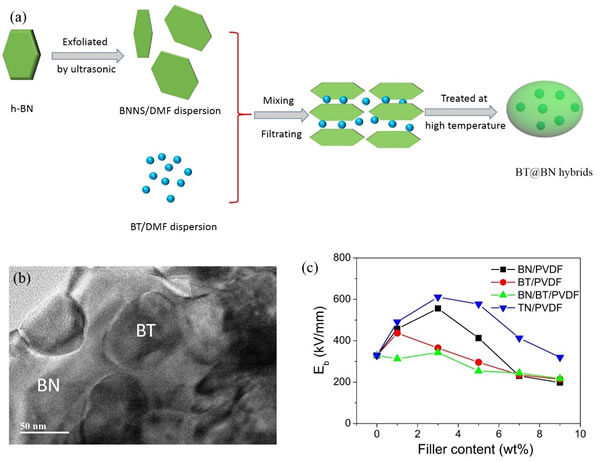Recently, the Institute of Advanced Materials Science and Engineering (Shenzhen), Shenzhen Institute of Advanced Technology, Chinese Academy of Sciences has made new progress in the field of dielectric energy storage materials. In this study, through the design of filler particles, barium titanate particles with high dielectric constant are combined with boron nitride nanosheets with high breakdown strength and high thermal conductivity to form composite particles with special structure and compound with polymers After that, the breakdown strength and dielectric energy storage performance of the composite material can be significantly improved. Related papers were published in Advanced under the title Significantly Enhanced Electrostatic Energy Storage Performance of Flexible Polymer Composites by Introducing Highly Insulating-Ferroelectric Microhybrids as Fillers. Energy Materials ("Advanced Energy Materials", 2018, 1803204). Senior engineer Luo Suibin is the first author, and researchers Yu Shuhui and Sun Rong are the corresponding authors. Dielectric energy storage technology has an exceptionally fast energy conversion rate, and has the characteristics of long working time and environmental friendliness. It has been widely used in modern electronic power industry such as wearable electronics, hybrid vehicles, weapon systems and other fields. With the development of electronic devices towards miniaturization and high performance, there is an urgent need for dielectric materials with high energy storage density. To this end, the research team mixed and dispersed the liquid dispersion of boron nitride nanosheets (BNNS) and barium titanate (BT) nanoparticles, and treated them at a higher temperature, to a certain extent, the molten BNNS tightly bound the BT particles Coated to form composite particles BT @ BN. Combined with the high insulation of boron nitride and the high dielectric constant of barium titanate, it reduces the space charge density and current density of PVDF composite materials, enhances the polarization of barium titanate, and obtains the breakdown strength (1.76 times of PVDF matrix) and The electrical displacement (electrical displacement is 9.3 μC / cm2 at 580 kV / mm) is significantly improved, resulting in a high energy storage density (17.6 J / cm3, 2.8 times of PVDF matrix) dielectric energy storage material. The research work was supported by the National Natural Science Foundation of China, the Ministry of Science and Technology, Guangdong University of Industry, Education and Research, and the Excellent Youth Project of the Advanced Institute. Lithium (Li) is a kind of silvery white metal, soft, with the minimum density of all metals. Relative atomic mass of lithium is 6.94, with the density of 0.534 g/cm3, melting point of 180℃. Due to the small atomic mass, the battery used lithium as the anode materials has a high energy density. In addition, Lithium Battery has the advantages of light weight, small size, long lifetime, good performance and so on. The battery field has become the largest application field of lithium. Shandong Zhongshan Photoelectric Materials Co., Ltd , https://www.cnzsem.com
(a) Schematic diagram of the preparation process of BT @ BN composite particles; (b) TEM photo of BT @ BN composite particles; (c) Breakdown strength of composite materials.